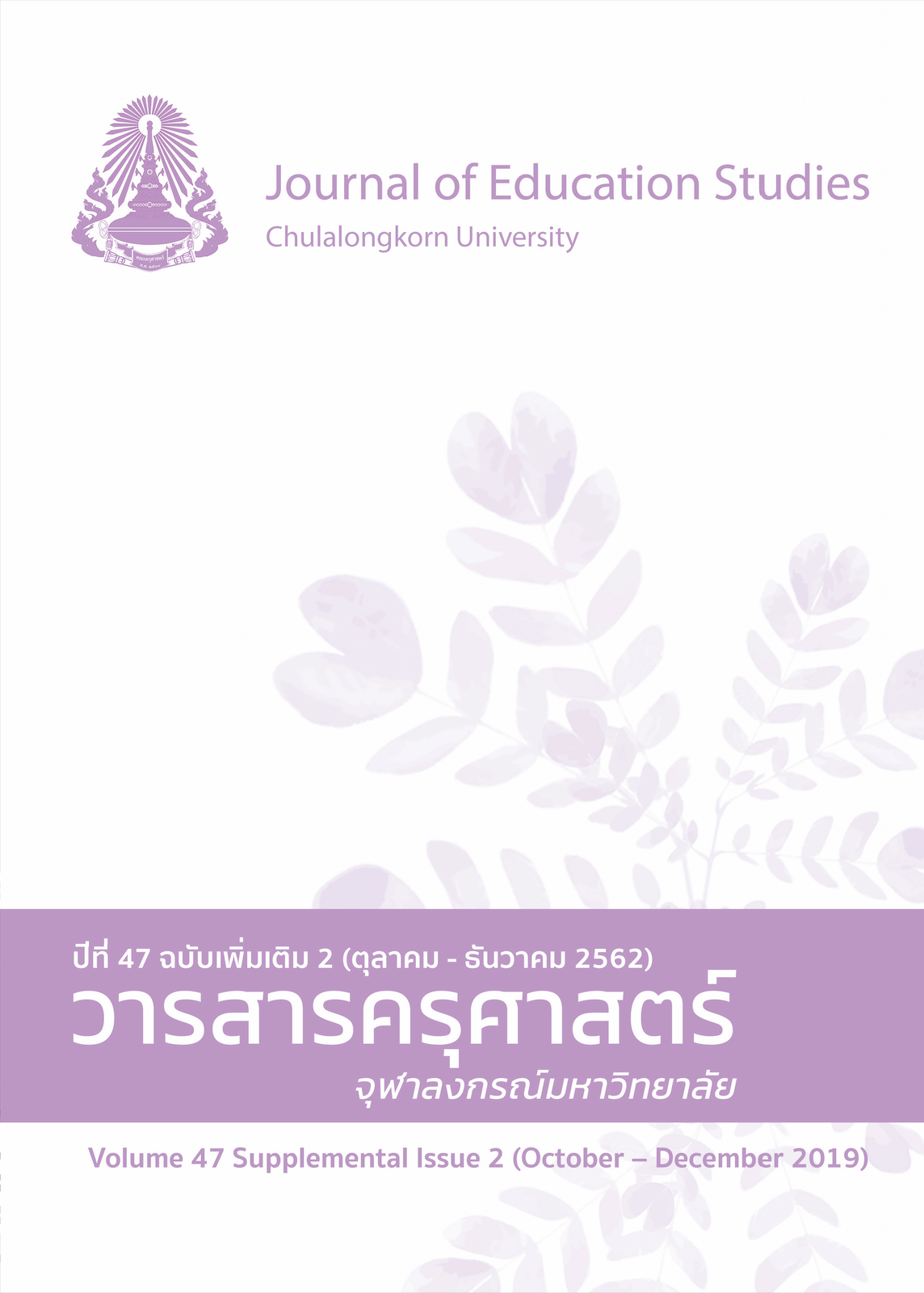Effects of Instruction Using Visualization of Chemistry Learning Design on Scientific Representations and Attitude towards Learning Chemistry of Upper Secondary School Students
Keywords:
VISUALIZATION OF THE CHEMISTRY LEARNING DESIGN, SCIENTIFIC REPRESENTATIONS, ATTITUDE TOWARD LEARNING CHEMISTRYAbstract
This research aimed to 1) study the scientific representations of students by using the visualization of Chemistry learning design, 2) compare students’ scientific representations between a group of students using the visualization of Chemistry learning design and ones using inquiry instruction. 3) study students’ attitude towards learning chemistry by using the visualization of Chemistry learning design. 4) compare students’ attitude towards learning chemistry between two groups, with one using the visualization of Chemistry learning design and the other using inquiry instruction. The samples were grad-10 students. One class of 44 students was used as the experimental group, using the visualization of Chemistry learning design, while another class of 43 students was used as the control group, using inquiry instruction. The research instruments were 1) the scientific representations test with reliability at 0.62, 2) the attitude toward learning chemistry test with reliability of 0.67. The research findings were summarized as follows: 1) The experimental group’s mean score of their scientific representations was rated at a moderate level; 2) The experimental group’s mean score of their scientific representations was higher than control group by a level of .05 significance; 3)The experimental group’s mean score of attitude towards learning chemistry was rated at a good level; 4) The experimental group’s mean score of the attitude toward learning chemistry was higher than control group by a level of .05 significance
References
ณัชธฤต เกื้อทาน. (2557). การพัฒนาแบบจำลองความคิดเรื่องพันธะเคมีของนักเรียนชั้นมัธยมศึกษาปีที่ 4 ด้วยกิจกรรมการเรียนรู้โดยใช้แบบจำลองเป็นฐาน (วิทยานิพนธ์ปริญญามหาบัณฑิต ไม่ได้ตีพิมพ์). มหาวิทยาลัยเกษตรศาสตร์, กรุงเทพมหานคร.
ดวงกมล บำรุงบ้านทุ่ม. (2555). ตัวแทนความคิด เรื่อง พันธะเคมี ของนักเรียนชั้นมัธยมศึกษาปีที่ 4 ที่เรียนจากการจัดกิจกรรมการเรียนรู้แบบเปรียบเทียบ (Analogy) ตามแนว FAR Guide. สืบค้นจาก http://gsmis.gs.kku.ac.th/student/student_detail/535050062.
พัชรินทร์ ศรีพล, นพมณี เชื้อวัชรินทร์, และ เชษฐ์ ศิริสวัสดิ์ (2556). การศึกษาผลสัมฤทธิ์ทางการเรียนและเจตคติต่อวิชาเคมีของนักเรียนชั้นมัธยมศึกษาปีที่ 4 ที่ได้รับการสอนโดยใช้รูปแบบวัฏจักรการสืบเสาะหาความรู้ 5 ขั้น (5E) ร่วมกับการ เรียนแบบร่วมมือเทคนิค STAD. วารสารการศึกษาและการพัฒนาสังคม, 9(2), 71-82.
พิมพันธ์ เดชะคุปต์. (2558). รู้เนื้อหาก่อนสอนเก่ง. กรุงเทพมหานคร: โรงพิมพ์แห่งจุฬาลงกรณ์มหาวิทยาลัย.
มรีจิ คงทรัตน์. (2553). ผลของการจัดการเรียนการสอนวิทยาศาสตร์โดยใช้เทคนิคแนวเทียบร่วมกับวงจรการเรียนรู้ 5E ที่มีต่อความสามารถในการแก้ปัญหาและเจตคติต่อวิทยาศาสตร์ของนักเรียนมัธยมศึกษาตอนต้น. (วิทยานิพนธ์ปริญญามหาบัณฑิต ไม่ได้ตีพิมพ์). จุฬาลงกรณ์มหาวิทยาลัย, กรุงเทพมหานคร.
วรรณี แกมเกตุ. (2555). วิธีวิทยาการวิจัยทางพฤติกรรมศาสตร์. กรุงเทพมหานคร: โรงพิมพ์แห่งจุฬาลงกรณ์มหาวิทยาลัย.
ภาษาอังกฤษ
Coll, R. K., & Treagust, D. F. (2003). Learners' mental models of metallic bonding: A cross‐age study. Science Education, 87(5), 685-707.
Dalton, R. M. (2003). The development of students’ mental models of chemical substances and processes at the molecular level (Doctoral Dissertation). Retrieved from https://researchdirect.westernsydney.edu.au/islandora/object/uws:816
Gilbert, J. K., & Treagust, D. F. (2009). Introduction: Macro, submicro and symbolic representations and the relationship between them: Key models in chemical education. In J. K. Gilbert & D. Treagust (Eds.), Multiple representations in chemical education (pp. 1-8). Germany: Springer, Dordrecht.
Gudyanga, E. & Madambi, T. (2014). Students’ Misconceptions about bonding and chemical structure in chemistry. Retrieved from http://ir.msu.ac.zw:8080/jspui/bitstream/11408/645/1/gudyanga2.pdf
Jaber, L. Z., & BouJaoude, S. (2012). A macro–micro–symbolic teaching to promote relational understanding of chemical reactions. International Journal of Science Education, 34(7), 973-998.
Jegede, S. A. (2007). Students' anxiety towards the learning of chemistry in some Nigerian secondary schools. Educational Research and Reviews, 2(7), 193.
Johnstone, A. H. (1993). The development of chemistry teaching: a changing response to a changing demand. Journal of Chemical Education, 70(9), 701–705.
Nyunt, N. N., & Aye, M. M. (2015). The attitude towards chemistry of grade 10 students. Education Research Journal, 5(1), 1-12.
Taber, K. S., & Coll, R. K. (2002). Bonding. In J. K. Gilbert, O. De Jong, R. Justi, D. F. Treagust, & J. H. Van Driel (Eds.), Chemical Education: Towards Research-based Practice. (pp. 213-234). Germany: Springer, Dordrecht.
Tasker, R., & Dalton, R. (2006). Research into practice: visualisation of the molecular world using animations. Chemistry Education Research and Practice, 7(2), 141–159.
Tasker, R., & Dalton, R. (2008). Visualizing the molecular world–design, evaluation, and use of animations. In Visualization: Theory and practice in science education. Sydney. Springer Netherlands.
Tien, L. T. (1998). fostering expert inquiry skills and beliefs about chemistry through the MORE laboratory experience (Doctoral Dissertation). Available from ProQuest
Dissertations and Theses. (AAI9902256)
Salta, K., & Tzougraki, C. (2004). Attitudes toward chemistry among 11th grade students in high schools in Greece. Science Education, 88(4), 535-547.
Savec, V. F., Sajovic, I., & Grm, K. S. W. (2009). Action Research to Promote the Formation of Linkages by Chemistry Students Between the Macro, Submicro, and Symbolic Representational Levels. Sydney. Springer Netherlands.
Yunus, F. W., & Ali, Z. M. (2012). Urban Students’ Attitude towards Learning Chemistry. Procedia-Social and Behavioral Sciences, 68(2012), 295-304.




